Introduction
In an effort to limit greenhouse gas emissions, President Biden signed an executive order that will require roughly 50% of new vehicles sold in the US to be electric by 2030. President Biden also signed the Bipartisan Infrastructure Law (BIL), earmarking significant funding explicitly for electric vehicle (EV) charging stations. Key programs under the law, such as the National Electric Vehicle Infrastructure (NEVI) Formula Program ($5 billion) and the Discretionary Grant Program for Charging and Fueling Infrastructure ($2.5 billion), represent tangible investments that champion the widespread installation of EV charging infrastructure.
The EV landscape surged in 2022, experiencing a record year despite ongoing global supply chain disruptions, economic uncertainties, and the aftereffects of the COVID-19 pandemic. Total new gas-powered vehicle sales between 2021 and 2022 declined by almost 25%. On the other hand EV sales (excluding Tesla), increased 56% in the same period. Tesla, which doesn’t directly report on sales, saw a 40% increase in deliveries year-over-year in 2022.
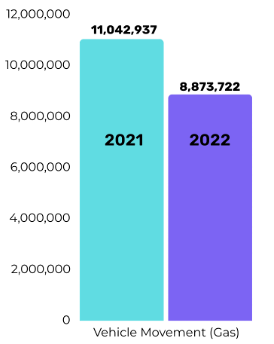
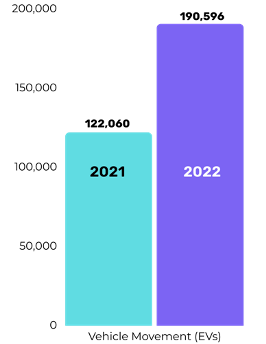
Source: Cloud Theory
However, amid increased sales, the concept of charging anxiety emerged as a critical barrier to widespread EV adoption. As previously mentioned in Cloud Theory’s 2023 Year in Review, despite the Biden Administration’s commitment to EVs and the growth of EV movement from 2021 to 2022, this automotive sector faced substantial headwinds. EV turn rates declined into early 2023 and fell below 30% for much of the year, while days-to-move doubled.
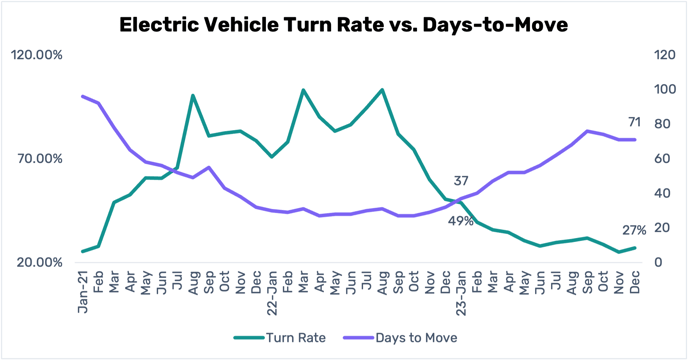 Source: Cloud Theory's 2023 Year In Review
Source: Cloud Theory's 2023 Year In Review
Charging + Range Anxiety
In the drive toward US consumers adopting electric vehicles in time to meet the 2030 deadline, there are two significant and related concerns that need to be addressed—range anxiety and charging anxiety. According to AAA, 58% of Americans have expressed concerns about the distance they would be able to drive on a single charge, a fear that keeps many consumers from making the switch to EVs. So despite promising trends, understanding and mitigating charging anxiety will be key to unlocking the full potential of electric vehicles and a wider adoption on a global scale.
Range Anxiety
Range anxiety is the fear or stress experienced by EV drivers regarding running out of battery power and being stranded without access to a charging station. The primary concern is insufficient battery charge, particularly during long-distance travel, where charging points may be scarce.
Charge Anxiety
Charge anxiety signifies feelings of uncertainty or negativity surrounding the access or utilization of a charging point. It has evolved into a predominant barrier to EV ownership, focusing specifically on concerns about charging station reliability. Factors such as long queues, vandalized or broken equipment, unreliable software or hardware, or occupied charging spots contribute to this concern. When comparing EV charging to tried and true (and quick) gasoline fill-ups, consumers need reassurance that charging station infrastructure investments will result in available and reliable resources to support their travel requirements.
The concern of these two anxieties can affect current EV or prospective EV owners. If not effectively managed, they may decrease the appeal of ownership or prompt current owners to reconsider their electric choices over gasoline-powered vehicles. Addressing these concerns is crucial for a smooth and confident transition toward widespread electric vehicle usage.
Charging Infrastructure Concerns
A recent "Plug In America" survey highlighted a crucial shift in the motivations of electric car buyers. The initial EV adopters were primarily driven by environmental concerns and thus willing to tolerate difficulties accessing public chargers. As electric vehicle adoption moves from focused to more widespread, this next wave of EV drivers has shown to be less forgiving of a poor public charging experience, impacting current and possibly future EV purchases more negatively.
Excess of EVs
In an attempt to keep pace with the looming government deadline, OEMs have already started to increase production on EVs. But starting on the 1st of 2024, the tax credit of $7,500 for an EV purchase was dropped from 24 qualifying models to just 12. With the aforementioned consumer charging/range anxiety, high car loan interest rates, and ever-increasing inflation worries, the EV turn rate has declined.
So, what can OEMs do to combat these issues and still stay profitable in a declining EV market?
First, the reliance on incentives, at least with EVs, is becoming less effective in overcoming consumer anxieties in the current economic environment. With the economic climate and the reduction in EV tax break availability, OEMs must rely on intelligent forecasting and data to turn a profit.
Cloud Theory’s Horizon platform can provide the level of detail needed for OEMs to survive and thrive in a challenging EV market. Horizon is a powerful automotive data solution designed to present an OEM with a complete visualization of a brand’s performance, with data and insights available at the model, trim, and fuel type level. Using sophisticated AI, machine learning, and real-time inventory and movement data, Horizon quickly identifies areas of opportunity based on relative supply and demand positions of vehicles across the entire U.S., from regional, state, or city levels. It can be customized to reflect the geographical definition of how an OEM defines their regions.
For example, for January 2024, Cloud Theory’s Horizon platform shows that active inventory and turn rate for new cars across the U.S. is 2.6m and 39.6%, respectively.
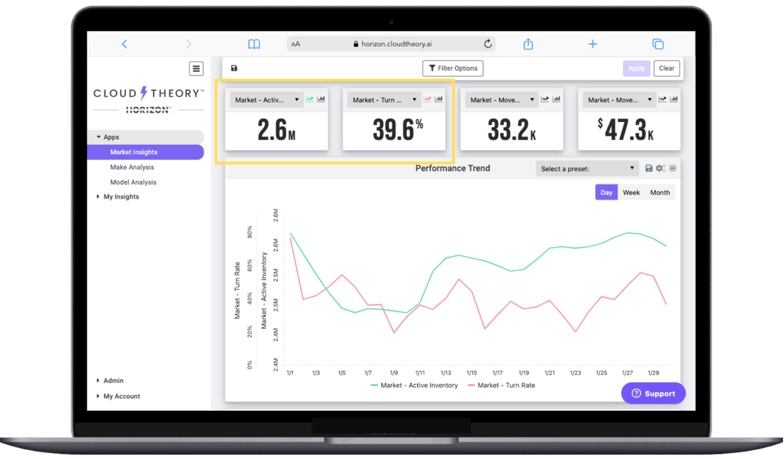
Horizon can break this number down further to show that active electric vehicle inventory for January is 137,591 (5% of total) and the turn rate is 29%–more than ten points lower than for all vehicles.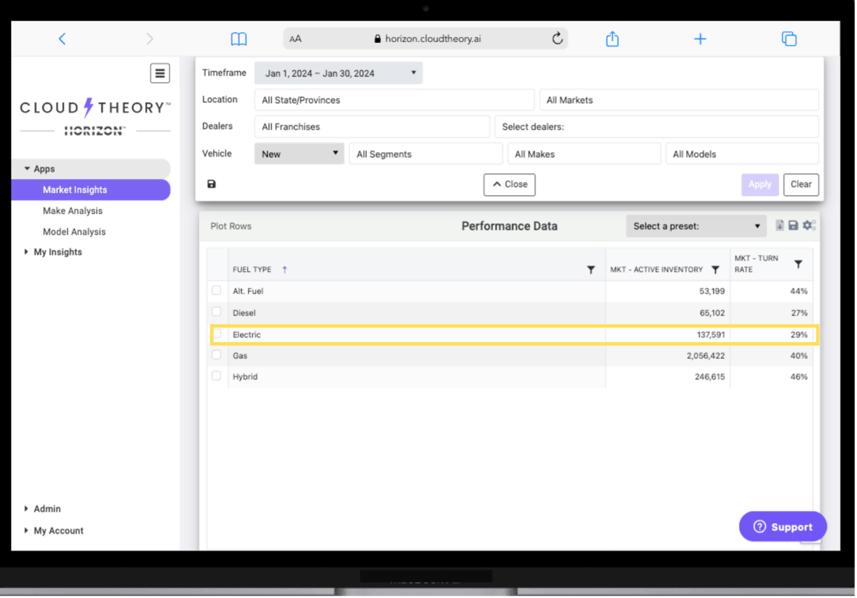
Horizon can look deeper into regional numbers as well. San Diego, CA has active new car inventory at 22.5K and a turn rate of 47.4%, higher than the US average.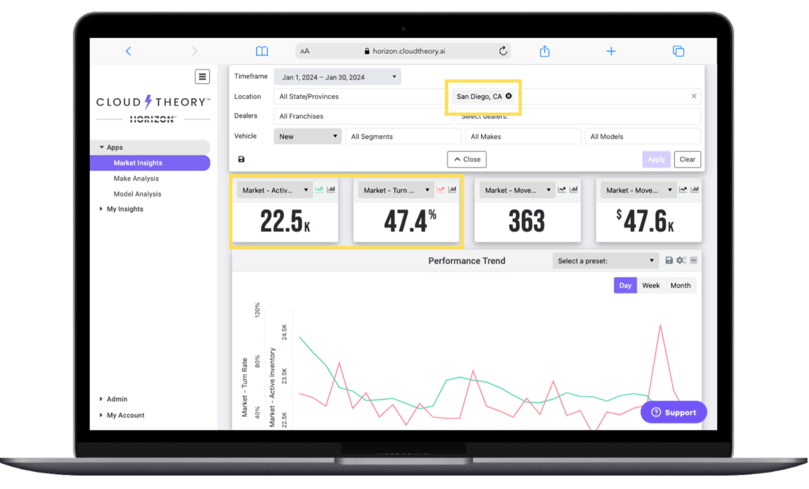
Looking just at electric vehicles, the active inventory is 2,998 (13% of total inventory in the DMA) and the turn rate is 32%, higher than average for the entire US.
With Horizon, an automotive OEM can pinpoint where electric cars are plentiful and turning more efficiently (like San Diego). With this knowledge, an automotive OEM can now strategically allocate inventory or incentives to areas that might need a push, with the knowledge of exactly how the current inventory is selling, including electric vehicles.
Future Outlook:
There is still plenty to expect within the world of EVs and charging infrastructure; society has yet to reach peak technological advancement.
Toyota has recently claimed a groundbreaking technological advancement that could revolutionize electric vehicles. Expected to manufacture solid-state batteries for EVs by 2027, Toyota's innovation promises to reduce charging times, increase capacity, and minimize the fire risk associated with conventional lithium-ion batteries. Another alternative charging method is dynamic in-road wireless charging, which uses devices embedded in the roadway that supply electricity to the EV as it is driving. Numerous trials are in place to demonstrate the feasibility of dynamic charging, which, with widespread implementation, could lead to smaller EV batteries that stay continuously charged and all but eliminate range anxiety.
The U.S government has currently attracted and invested around $150 billion in EVs and charging since Biden took office. This commitment by the Biden administration along with innovative new partnership models and increasing standardization, EV drivers can expect continuous improvement in EV charging. Hopefully, these improvements will help ease the worry of charging and range anxiety.
Building Consumer Confidence in EVs and Charging Infastructure
For the US to reach the 2030 electric vehicle sales goal, many improvements still need to be made. Consumers need confidence that they can rely on EVs the same way they've come to rely on traditional gas and diesel-powered cars. Not only that, but prospective EV owners have to feel secure knowing that, should they need to charge their EVs, the US roadways will have adequate charging stations.
OEMs also need confidence in where they choose to distribute their EV inventory and the knowledge that those EVs will sell even while facing a general downturn in consumer buying behavior. Cloud Theory's Horizon is the premier source for marketing planning, incentive optimization, inventory allocation, and 24/7 access to faster and more timely data.

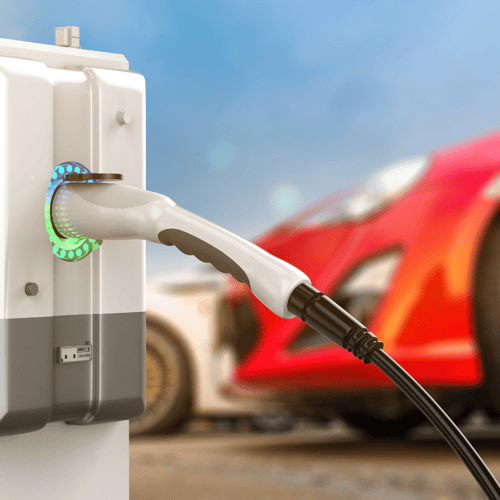

.png?width=300&height=175&name=Untitled%20design%20(62).png)
